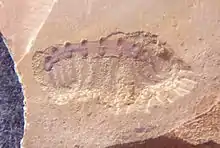Microdictyon
Microdictyon is an extinct armoured worm-like panarthropod coated with net-like scleritic plates, known from the Early Cambrian Maotianshan shale of Yunnan China and other parts of the world. Microdictyon is part of the ill-defined taxon – Lobopodia – that includes several other odd worm-like animals that resembling worm with legs, such as Hallucigenia, Onychodictyon, Cardiodictyon, Luolishania, and Paucipodia. The isolated sclerites of Microdictyon are known from other Lower Cambrian deposits. Microdictyon sclerites appear to have moulted; one sclerite seems to have been preserved during ecdysis.[1]
| Microdictyon Temporal range: | |
|---|---|
 | |
| Diagrammatic reconstruction of Microdictyon sinicum | |
 | |
| Microdictyon sinicum Fossil | |
| Scientific classification | |
| Domain: | Eukaryota |
| Kingdom: | Animalia |
| Stem group: | Onychophora |
| Genus: | †Microdictyon Bengtson, Matthews & Missarzhevsky, 1986 |
| Type species | |
| Microdictyon effusum Bengtson, Matthews & Missarzhevsky, 1986 | |
| Species | |
|
See text | |
Microdictyon sinicum (Chen, Hou and Lu, 1989) is typical. The wormlike animal has ten pairs of sclerites (suggestions that these may be eyes or eye-like structures have no weight[2]) on the sides, matched to a pair of tentacle-like feet below. The head and posterior are tubular and featureless.
Species composition
- Type species. Microdictyon effusum Bengtson, Matthews et Missarzhevsky, 1981; Lower Cambrian, Atdabanian Stage, Kazakhstan; Atdabanian and Botomian Stages, Russia (Siberian Platform) and England; Lower Cambrian, Sweden.
In addition to the type species, 13 species:[3]
- M. anus Tong, 1989, Lower Cambrian, upper Meishucunian Stage (= Atdabanian Stage), China (Shaanxi).
- M. chinense (Hao et Shu, 1987), Lower Cambrian, Qiongzhusi Stage (= upper Atdabanian-lowermost Botomian Stages), China (Shaanxi); Atdabanian through Botomian stages, Siberian Platform.
- M. cuneum Wotte et Sundberg, 2017, Lower Cambrian, Montezuman Stage, the United States.[4]
- M. depressum Bengtson, 1990, Lower Cambrian, Atdabanian through Botomian Stages, South Australia.
- M. fuchengense Li et Zhu, 2001, Lower Cambrian, upper Meishucunian Stage (Atdabanian Stage), China (Shaanxi).
- M. jinshaense Zhang et Aldridge, 2007, Lower Cambrian, Qiongzhusi Stage (= upper Atdabanian Stage-lowermost Botomian), China(Shaanxi).[2]
- M. montezumaensis Wotte et Sundberg, 2017, Lower Cambrian, Montezuman Stage, the United States.[4]
- M. rhomboidale Bengtson, Matthews et Missarzhevsky, 1986, Lower Cambrian, upper parts of the Atdabanian Stage, Kazakhstan; Atdabanian Stage, Canada, the United States (M. cf. rhomboidale).
- M. robisoni Bengtson, Matthews et Missarzhevsky, 1986, Middle Cambrian, Amgan Stage, the United States;
- M. rozanovi Demidenko, 2006, Lower Cambrian, Toyonian Stage, Siberian Platform.[3]
- M. sinicum Chen, Hou et Lu, 1989, Lower Cambrian, upper Meishucunian Stage (= Atdabanian Stage) Stage, China (Yunnan.
- M. sphaeroides Hinz, 1987, Lower Cambrian, Atdabanian Stage, Great Britain.
- M. tenuiporatum Bengtson, Matthews et Missarzhevsky, 1986, Lower Cambrian, Atdabanian Stage, Siberian Platform.
A picture can be found at https://web.archive.org/web/20030730043530/http://paws.wcu.edu/dperlmutr/earlyfauna.html.
The name Microdictyon is also used for a genus of green algae.
References
- Figured in Dzik, J. (2003). "Early Cambrian lobopodian sclerites and associated fossils from Kazakhstan" (PDF). Palaeontology. 46: 93–112. doi:10.1111/1475-4983.00289. S2CID 84215636.
- Zhang, X. -G.; Aldridge, R. J. (2007). "Development and Diversification of Trunk Plates of the Lower Cambrian Lobopodians". Palaeontology. 50 (2): 401. doi:10.1111/j.1475-4983.2006.00634.x. S2CID 85293118.
- Demidenko, Yu. E. (2006). "New Cambrian lobopods and chaetognaths of the Siberian Platform". Paleontological Journal. 40 (3): 234–243. doi:10.1134/S0031030106030026. S2CID 84550843.
- Thomas Wotte; Frederick A. Sundberg (2017). "Small shelly fossils from the Montezuman–Delamaran of the Great Basin in Nevada and California". Journal of Paleontology. 91 (5): 883–901. doi:10.1017/jpa.2017.8.